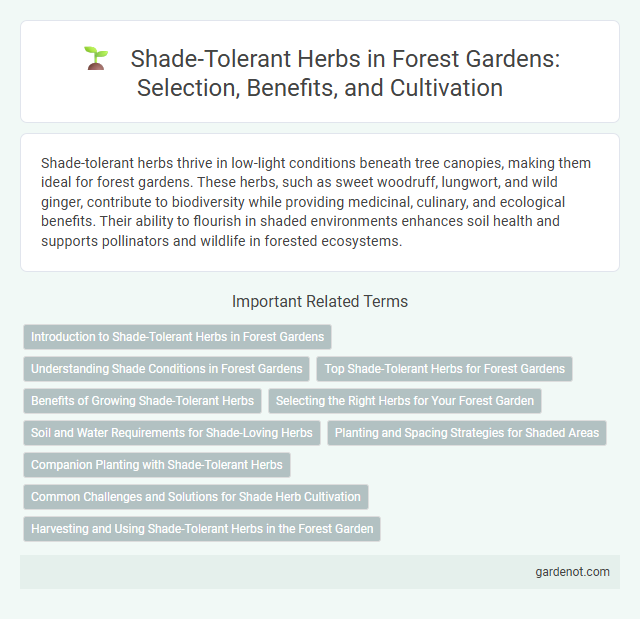Shade-tolerant herbs thrive in low-light conditions beneath tree canopies, making them ideal for forest gardens. These herbs, such as sweet woodruff, lungwort, and wild ginger, contribute to biodiversity while providing medicinal, culinary, and ecological benefits. Their ability to flourish in shaded environments enhances soil health and supports pollinators and wildlife in forested ecosystems.
Introduction to Shade-Tolerant Herbs in Forest Gardens
Shade-tolerant herbs are essential components of forest gardens, thriving under the canopy where sunlight is limited. Herbs such as wood sorrel (Oxalis acetosella), sweet woodruff (Galium odoratum), and wild ginger (Asarum canadense) adapt to low-light conditions while enhancing soil health and biodiversity. Integrating these shade-adapted herbs promotes sustainable forest ecosystems and provides culinary, medicinal, and ecological benefits.
Understanding Shade Conditions in Forest Gardens
Shade-tolerant herbs such as sweet woodruff and lungwort thrive under low-light conditions typical of forest gardens, benefiting from dappled sunlight filtered through canopy layers. Understanding the spectrum and duration of shade--ranging from deep shade under dense deciduous trees to partial shade beneath conifers--is critical for selecting appropriate herb species. Monitoring microclimates and light intensity using tools like PAR sensors enables precise matching of shade-tolerant herbs to their optimal forest garden niches, ensuring robust growth and ecological balance.
Top Shade-Tolerant Herbs for Forest Gardens
Top shade-tolerant herbs for forest gardens include wood sorrel (Oxalis acetosella), sweet woodruff (Galium odoratum), and wild ginger (Asarum canadense), all thriving under dense tree canopies. These herbs enhance biodiversity by providing ground cover, improving soil health through natural mulch, and supporting pollinators with their subtle blooms. Integrating shade-tolerant herbs in forest gardens promotes a resilient ecosystem while offering culinary and medicinal benefits.
Benefits of Growing Shade-Tolerant Herbs
Shade-tolerant herbs such as mint, lemon balm, and chives thrive under tree canopies, maximizing space utilization in forest gardens. These herbs improve soil health by enhancing organic matter and supporting beneficial microbial activity, contributing to a resilient ecosystem. Growing shade-tolerant herbs also promotes biodiversity, attracts pollinators, and provides fresh, flavorful ingredients for culinary and medicinal use year-round.
Selecting the Right Herbs for Your Forest Garden
Selecting shade-tolerant herbs such as sweet woodruff, mint, and lemon balm enhances the understory of a forest garden by thriving in low-light conditions beneath tree canopies. These herbs contribute to soil health, attract beneficial insects, and provide culinary and medicinal uses, making them multifunctional components of a diverse forest garden ecosystem. Prioritizing native and well-adapted shade herbs ensures sustainable growth and maximizes the ecological benefits in shaded garden areas.
Soil and Water Requirements for Shade-Loving Herbs
Shade-tolerant herbs thrive in moist, well-drained soil rich in organic matter, essential for maintaining nutrient availability and soil structure. Consistent watering is critical, as these herbs prefer evenly hydrated conditions without waterlogging, which supports healthy root development and foliage growth. Selecting soil with good moisture retention yet adequate drainage ensures optimal water balance necessary for shade-loving herbs in forest garden ecosystems.
Planting and Spacing Strategies for Shaded Areas
Shade-tolerant herbs such as wood sorrel, sweet woodruff, and ajuga thrive under dense tree canopies by requiring minimal direct sunlight. Planting these herbs with 8-12 inch spacing ensures adequate air circulation and reduces competition for nutrients in shaded areas of a forest garden. Utilizing mulch around these herbs helps retain soil moisture and suppress weeds, optimizing growth in low-light conditions.
Companion Planting with Shade-Tolerant Herbs
Shade-tolerant herbs such as mint, chives, and lemon balm thrive under the canopy of forest gardens, enhancing biodiversity and soil health through companion planting. These herbs improve pest resistance by repelling harmful insects and attract beneficial pollinators, supporting nearby fruit trees and shrubs. Integrating shade-tolerant herbs into forest garden layers maximizes space efficiency and sustains a resilient, self-sufficient ecosystem.
Common Challenges and Solutions for Shade Herb Cultivation
Shade-tolerant herbs like sweet woodruff and wild ginger often face challenges such as limited sunlight, increased humidity, and poor air circulation in forest garden environments. These conditions can lead to slow growth, fungal diseases, and nutrient deficiencies, which require soil enrichment with organic matter and strategic spacing to improve airflow. Implementing mulch to retain moisture while preventing waterlogging also enhances the health and productivity of shade-loving herbs.
Harvesting and Using Shade-Tolerant Herbs in the Forest Garden
Shade-tolerant herbs such as wild ginger, wood sorrel, and sweet cicely thrive under the canopy of a forest garden, allowing for efficient use of shaded spaces. Harvesting these herbs involves careful hand-picking of leaves, stems, or roots depending on the species, ensuring sustainability and continued growth. These herbs can be used fresh or dried for culinary flavoring, medicinal teas, and natural remedies, enhancing the biodiversity and productivity of the forest garden ecosystem.
Shade-tolerant herb Infographic

 gardenot.com
gardenot.com